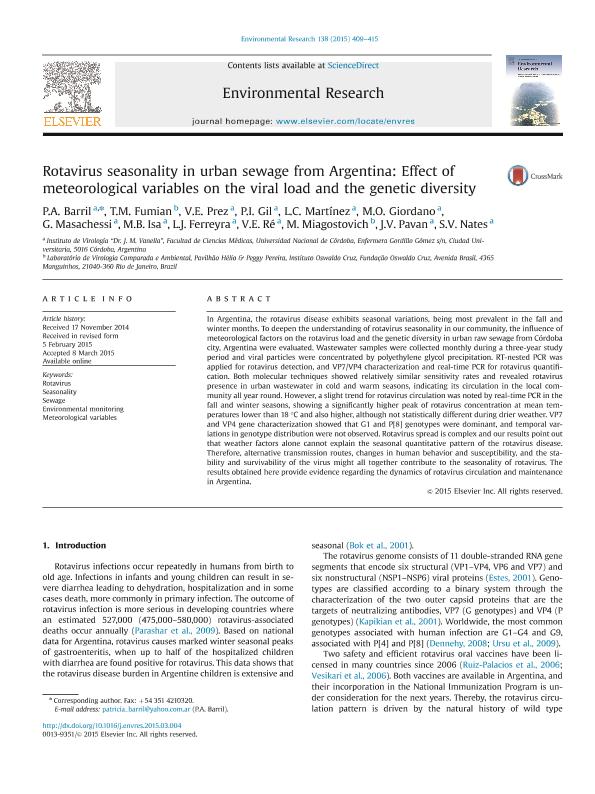Artículo
Rotavirus seasonality in urban sewage from Argentina: Effect of meteorological variables on the viral load and the genetic diversity
Barril, Patricia Angelica ; Fumian, T. M.; Prez, Verónica Emilse
; Fumian, T. M.; Prez, Verónica Emilse ; Gil, Pedro Ignacio; Martínez, L. C.; Giordano, Miguel Oscar; Masachessi, Gisela
; Gil, Pedro Ignacio; Martínez, L. C.; Giordano, Miguel Oscar; Masachessi, Gisela ; Isa, Maria Beatriz; Ferreyra, Leonardo Jesús; Ré, Viviana Elizabeth
; Isa, Maria Beatriz; Ferreyra, Leonardo Jesús; Ré, Viviana Elizabeth ; Miagostovich, M.; Pavan, Jorge Victorio; Nates, Silvia Viviana
; Miagostovich, M.; Pavan, Jorge Victorio; Nates, Silvia Viviana
 ; Fumian, T. M.; Prez, Verónica Emilse
; Fumian, T. M.; Prez, Verónica Emilse ; Gil, Pedro Ignacio; Martínez, L. C.; Giordano, Miguel Oscar; Masachessi, Gisela
; Gil, Pedro Ignacio; Martínez, L. C.; Giordano, Miguel Oscar; Masachessi, Gisela ; Isa, Maria Beatriz; Ferreyra, Leonardo Jesús; Ré, Viviana Elizabeth
; Isa, Maria Beatriz; Ferreyra, Leonardo Jesús; Ré, Viviana Elizabeth ; Miagostovich, M.; Pavan, Jorge Victorio; Nates, Silvia Viviana
; Miagostovich, M.; Pavan, Jorge Victorio; Nates, Silvia Viviana
Fecha de publicación:
04/2015
Editorial:
Academic Press Inc Elsevier Science
Revista:
Environmental Research
ISSN:
0013-9351
Idioma:
Inglés
Tipo de recurso:
Artículo publicado
Clasificación temática:
Resumen
In Argentina, the rotavirus disease exhibits seasonal variations, being most prevalent in the fall and winter months. To deepen the understanding of rotavirus seasonality in our community, the influence of meteorological factors on the rotavirus load and the genetic diversity in urban raw sewage from Córdoba city, Argentina were evaluated. Wastewater samples were collected monthly during a three-year study period and viral particles were concentrated by polyethylene glycol precipitation. RT-nested PCR was applied for rotavirus detection, and VP7/VP4 characterization and real-time PCR for rotavirus quantification. Both molecular techniques showed relatively similar sensitivity rates and revealed rotavirus presence in urban wastewater in cold and warm seasons, indicating its circulation in the local community all year round. However, a slight trend for rotavirus circulation was noted by real-time PCR in the fall and winter seasons, showing a significantly higher peak of rotavirus concentration at mean temperatures lower than 18. °C and also higher, although not statistically different during drier weather. VP7 and VP4 gene characterization showed that G1 and P[8] genotypes were dominant, and temporal variations in genotype distribution were not observed. Rotavirus spread is complex and our results point out that weather factors alone cannot explain the seasonal quantitative pattern of the rotavirus disease. Therefore, alternative transmission routes, changes in human behavior and susceptibility, and the stability and survivability of the virus might all together contribute to the seasonality of rotavirus. The results obtained here provide evidence regarding the dynamics of rotavirus circulation and maintenance in Argentina.
Archivos asociados
Licencia
Identificadores
Colecciones
Articulos(CCT - CORDOBA)
Articulos de CTRO.CIENTIFICO TECNOL.CONICET - CORDOBA
Articulos de CTRO.CIENTIFICO TECNOL.CONICET - CORDOBA
Citación
Barril, Patricia Angelica; Fumian, T. M.; Prez, Verónica Emilse; Gil, Pedro Ignacio; Martínez, L. C.; et al.; Rotavirus seasonality in urban sewage from Argentina: Effect of meteorological variables on the viral load and the genetic diversity; Academic Press Inc Elsevier Science; Environmental Research; 138; 4-2015; 409-415
Compartir
Altmétricas



